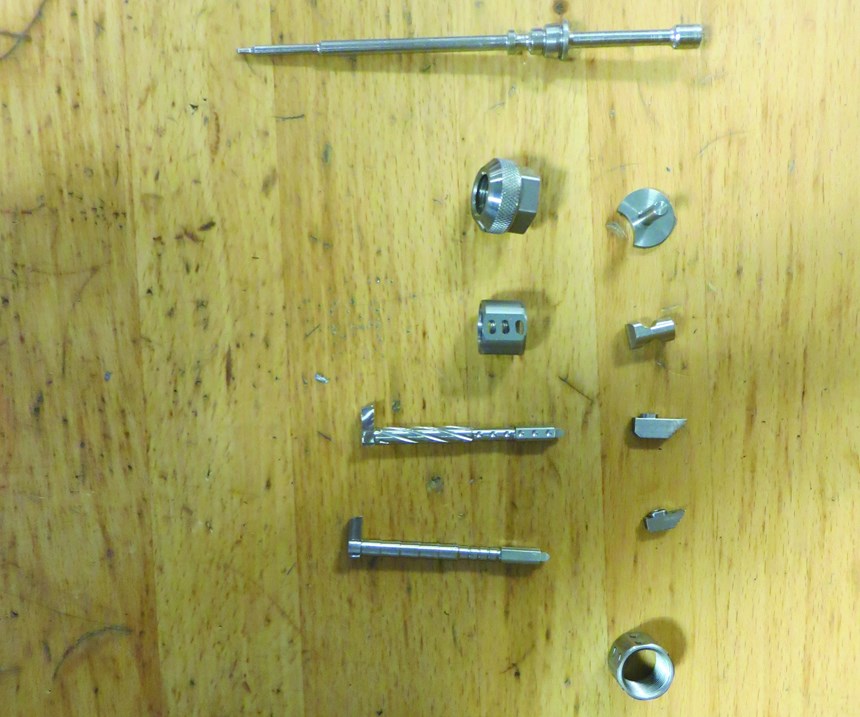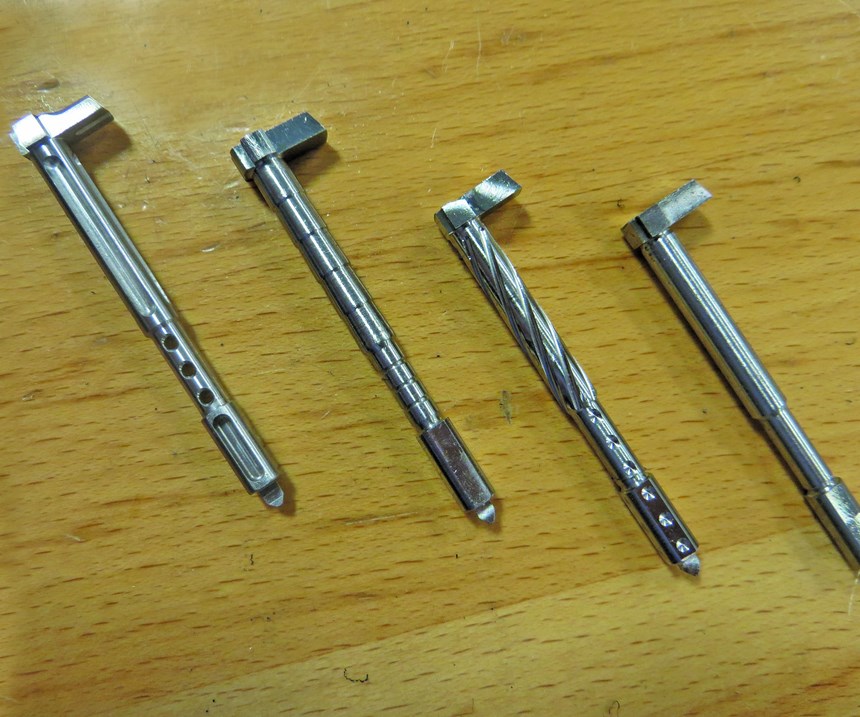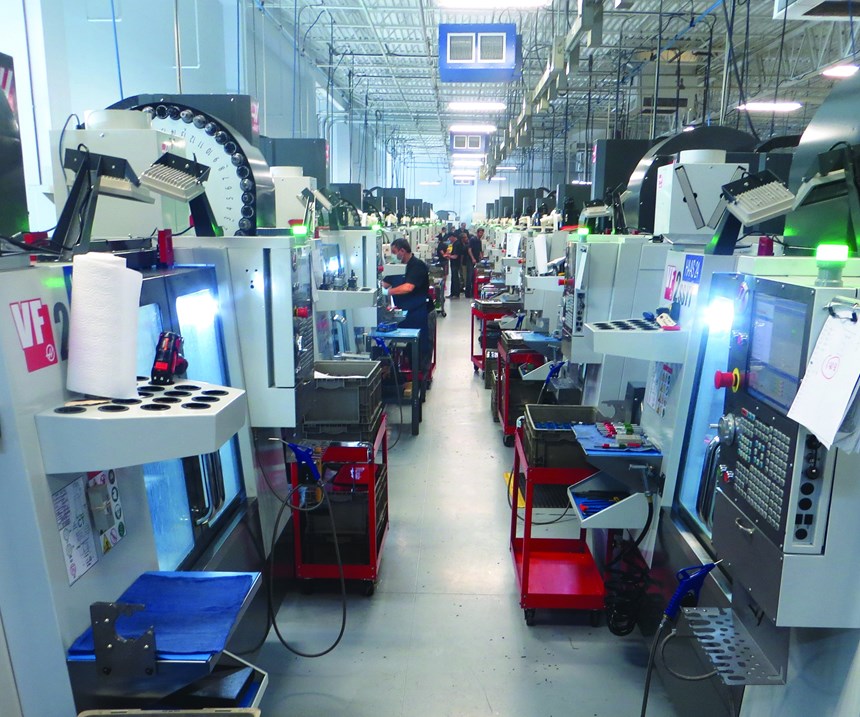Locked and Loaded for Further Growth in Firearms Production
Even with a strong and varied manufacturing background, it wasn’t until a few years ago that this father and son team found its way into the manufacture of weaponry components. Nonetheless, business is booming.
Numerous factors can play into the ebb and flow of firearms production. Predictions surrounding the last presidential election and related concerns about gun control, for instance, drove up sales of certain models such as the AR platform, only for demand to sharply decline once the votes were counted. As with many other manufacturing sectors, the cyclical nature of this market can force shops to broaden their scope, reaching out to other areas to strategically diversify their operations. But some may view this step as a sure way to stagnate technological advancement by limiting specialization. To quickly grow as a prominent supplier of firearms components, one Naples, Florida, shop has remained specifically focused in this area of manufacturing.
Specialization
Len Zaiser III is a self-proclaimed machine tool nut. His love for the industry is reflected in his life-long devotion to his career in making parts. He no doubt handed much of this enthusiasm down to his son, Len Zaiser IV. The two previously owned a contract manufacturing company together, producing complex five-axis medical implants to some of the biggest medical supply companies in the world.
After selling the medical implant shop, the Zaisers began considering other possibilities. They observed what they viewed as inefficiencies in the firearms industry, and realizing they could establish a significant niche there, opened Azimuth Technology in 2012. The company does everything from full assembly of light firearms to components, producing many small firearms products such as match grade barrels and slides for such name brand products as Glock, H&K, Smith and Wesson and Beretta, along with grenade launchers, suppressors and IED finders. Lot sizes range from a few hundred to tens of thousands in such materials as aluminum, titanium, stainless steel and unique alloys.
The Zaisers do not consider themselves weapons specialists, but rather manufacturing specialists who find ways to make things better and more efficiently. And they feel that by focusing on one specific end market, they can refine the production process to a highly competitive art. But there is a little more to it, as weapons manufacturing can require a fair number of qualifiers. As such, beyond being ISO 9001:2008 certified, Azimuth is DOD-registered, it has a Commercial and Government Entity (CAGE) code to identify as a supplier to defense agencies, it’s licensed in International Traffic in Arms Regulations (ITAR) for export of defense-related articles and services, and it has class 7 and 10 ATF licenses to allow the production and sale of destructive devices such as grenade launchers.
The younger Mr. Zaiser says they have spent a lot of time, effort and money building their “Field of Dreams,” and the customers are coming in droves. The company’s services are in such demand that capacity limitations forced 60 percent of the potential business to be turned away last year. It’s clear why there’s no real need to reach out into other areas of manufacturing. The philosophy seems to be working, as the company has quickly grown to 130 employees and 107 CNC machines, making an assortment of products for more than 130 different customers.
Applying Swiss
The Zaisers were first introduced to Tsugami/REM Sales LLC Swiss machines at their medical implant business, where the machines were used in the production of bone screws. Azimuth now runs two Tsugami B0125s, two SS20s, and one B0206 on lot sizes from 500 to 50,000 pieces. The younger Mr. Zaiser says Tsugami machines will be the only Swiss machines his company will ever own. He is currently looking to acquire a slant-bed lathe with a Y axis on the turret.
Most of the parts the company produces start from bar material, whether completed on the Swiss machines or eventually handed off to the milling centers. When the company first opened, it was running aluminum bronze bushings on the lathes. Now more common parts are cam pins, firing pins, ejectors, extractors, and firing pins within the 20-mm window. Materials range from aluminum nickel bronze to 4340, as well as titanium.
The Swiss design has been beneficial in helping to conserve precious, limited floor space. “With square footage at a premium, we fit in machines that can do both side A and side B, turning and milling, and they can run unattended,” says Adam Naylor, turning operations manager.
Material to Parts
The company runs two shifts, with employees on the floor 20 hours a day, but the Tsugamis run 24 hours a day. LNS bar feeders supply each of these machines with material. With a half-inch bar, 15 bars of material can be loaded, which is usually enough to run all day. The Swiss machines also include a chucker package that helps to cut down on remnant losses. “Instead of running a 12-foot bar and losing the last 8 or 11 inches of the bar on the drop, chucker mode brings that down to 2 or 3 inches at most,” Mr. Naylor says.
Converting to chucker mode is relatively simple. The operator removes the guide bushing and places a protective plate in place. The Z1 access comes all the way up to the main wall in the machine, allowing it to run as a standard chucker.
Once the parts have been completed on the Tsugami, they go to a wash and tumbling operation and, depending on the part, they may then go straight to the customer or else to heat treating.
Typically, about 10 different parts will run across the Tsugamis per week, and more than 100 different parts have been produced on them since the company opened. Many of the parts are stand-alone, but Azimuth also does about 25,000 assemblies per month.
Mr. Naylor says it is usability that keeps the company coming back to Tsugami. “They’re extremely user friendly, and the FANUC controls are solid,” he says. The consistency from one machine to the next pays off as operators can move from machine to machine with little downtime or program changes.
One common part for the company is a Glock firing pin, which is machined complete on the SS20 machines. Made from 17-4 stainless, about 90 percent of the part is machined on the main spindle. While they haven’t been able to balance more of the work to the subspindle, Mr. Naylor says the savings by keeping it on a single machine, with one setup and one operator makes it a good project.
Dayler Botet, the Swiss turn lead, has been heading up the firing pin project. He explains that with the big diameter (3/4 inch), it needs to be done section by section, keeping the part close to the guide bushing to maintain rigidity and reduce vibration.
Mr. Botet says he likes the Tsugami machines because they can run non-stop with little maintenance. To show this longevity, he points out one of the B0125 machines that has been running an ejector for the AR-15 for two months straight, 24 hours a day, 7 days a week, maintaining tight tolerances.
Programming
Azimuth uses a few different CAM systems, depending on the machines they’re programming. For the lathes, Partmaker is the main resource. “PartMaker has made my life amazingly easy,” Mr. Naylor says. He had no CAM programming experience when he started at Azimuth. “It was old school, where I’d take my block of metal to the machine and write my program right there. It got the job done, and it worked, but the time savings we see now by doing the programming offline is amazing.” When one part is finished, the next program is already created.
Now Mr. Botet does most of the prototyping and programming for the Swiss machines. He says the postprocessors for the Tsugami machines have been flawless. He’s been able to easily do design changes on the fly as well, including multiple varieties of the Glock firing pin.
VMCs Fit Here, Too
Much of the production at Azimuth Technology is performed on 35 Haas Automation, Inc.vertical machining centers (VMCs), each with a fourth-axis rotary indexer. The vertical design was first selected by the company for space considerations, but has proven beneficial in other ways as well.
“My father talks about putting parts on machines that are simpler and breaking the process down into its simplest form,” the younger Mr. Zaiser says. The vertical design is predisposed to faster, easier setups than the horizontal, which is an important feature for this shop that is often in and out of projects within hours. “We don’t have the luxury of running a million of any given part. We’re more of a glorified job shop, so we need the ability to change out within a half a day.”
The Haas machines that the company orders now are loaded with high pressure coolant, a 40-tool carousel, and the Wireless Intuitive Probing System (WIPS) with Renishaw probe. Still they offer cost benefits that Mr. Zaiser says allow the company to bring in two and a half to three times the number of machines versus the horizontals. And they do. Azimuth typically purchases four to six machines at a time.
When the Zaisers started the company in 2012, they needed equipment fast. They talked with other machine tool suppliers who were quoting delivery times of six to 12 months out. They were familiar with Haas machines from their previous company, where they had a small office mill with a 30,000-rpm spindle making electrodes for a sinker EDM. Haas was able to deliver six VF-2SSYT machines in two weeks, and by the end of the third week, all six machines were producing complex parts.
The Haas machines are now producing mostly drop-in pistol barrels, bolt carriers and bolts for the AR-15, and recently slides and semi-automatic slides. Material is mostly stainless 416r gun barrel quality or 416 standard, 9310 alloy steel and 8620 alloy.
Manufacturing Manager Nick Chylinski says the machines are particularly user friendly. “We get people who come in with little to no experience and put them in front of a Haas mill for a week, and they get it,” he says. All of the employees are trained in-house, including a lot of cross-training. Many of the other machines on the floor use FANUC controls, and he says the employees can easily move from a FANUC to a Haas control with little interruption of productivity.
Overall, these VMCs have been a good fit for Azimuth. The machines run 20 hours a day, six days a week with 85-percent efficiency or better. The combination of these machine with the efficient work of the Tsugami Swiss machines has helped Azimuth grow beyond its walls. The company has used every inch of the current 30,000-square-foot manufacturing space, and expansion has begun for an additional 30,000 square feet. Clearly its strategy of specializing in weapons production is paying off.
Related Content
Software Controls Chip Breaking in Thread Turning Operations
This cutting tool manufacturer has developed a software module for chip control of thread turning operations in virtually any CNC lathe, even for older machines, using specific tooling and software.
Read MoreShop Optimizes its Swiss-Turning Flexibility
Paramount Machine uses various Swiss-type lathes, some with a B axis, to produce parts more effectively than it did on conventional chucker lathes. Today, nearly every job under 1.5 inches in diameter runs across those machines even if the batch size is a mere 5 pieces.
Read MoreLaser Technology "Turns" into a Turning Tool
This new technology uses a laser to act as a cutting tool to "turn" parts from solid barstock. This high-speed precision turning machine is especially useful for micromachining, enabling high accuracy for small, complex parts that are often delicate and difficult to machine when implementing conventional turning processes.
Read More5-Axis Machining Centers Transform Medical Swiss Shop
Traditionally a Swiss machine shop, Swiss Precision Machining Inc. discovers a five-axis machining center that has led the company to substantial growth. (Includes video.)
Read MoreRead Next
Advances in Swiss-Type Technology
R&D efforts in recent years have led to higher efficiencies, increased agility and expanded capabilities for shops performing Swiss-type turning.
Read MoreDo You Have Single Points of Failure?
Plans need to be in place before a catastrophic event occurs.
Read MoreEmerging Leaders Nominations Now Open
Here’s your chance to highlight a young person in your manufacturing business who is on the path to be a future leader moving your company forward.
Read More












.jpg;maxWidth=300;quality=90)













